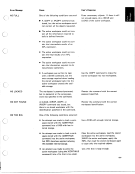El
The I Function: Decode (Base Value )
Monadic (One-Argument) Form
There is no monadic form.
Dyadic (Two-Argument) Form: Decode AIB
The decode function result is the value of argument B expressed in the number
system specified by argument A. For example, to convert 1776 to its value in the
decimal number system (base 10):
1. 0 1. 0 :I. 0 :I. I1 .I. :I. ‘7 ‘7 6
Y.7’76
The following illustration shows how it was done:
Argument A (number system) specifies the following:
I
10 10 10 10
-Ten units in each of these positions
equals one unit of the next position
to the left.
Argument B is a vector with these values:
1776
The result is the same as doing the following:
6= 6 The units position always represents itself.
700 \The value in the next position is multiplied
7 x10 = 70
7 xlOxl0 =
I x10x10x10= 1000 by the rightmost value in argument A.
1776
The value in the next position is multiplied
by the two rightmost values in argument A,
and so on.
-\
The arguments must be numeric. If one argument is a scalar or single-element array,
the other argument can be a scalar, vector, or other array. The result will have the
rank of the larger argument minus one.
96
The I Function: Decode (Base Value )
Monadic (One-Argument) Form
There is no monadic form.
Dyadic (Two-Argument) Form: Decode AIB
The decode function result is the value of argument B expressed in the number
system specified by argument A. For example, to convert 1776 to its value in the
decimal number system (base 10):
1. 0 1. 0 :I. 0 :I. I1 .I. :I. ‘7 ‘7 6
Y.7’76
The following illustration shows how it was done:
Argument A (number system) specifies the following:
I
10 10 10 10
-Ten units in each of these positions
equals one unit of the next position
to the left.
Argument B is a vector with these values:
1776
The result is the same as doing the following:
6= 6 The units position always represents itself.
700 \The value in the next position is multiplied
7 x10 = 70
7 xlOxl0 =
I x10x10x10= 1000 by the rightmost value in argument A.
1776
The value in the next position is multiplied
by the two rightmost values in argument A,
and so on.
-\
The arguments must be numeric. If one argument is a scalar or single-element array,
the other argument can be a scalar, vector, or other array. The result will have the
rank of the larger argument minus one.
96









































































































































































































































